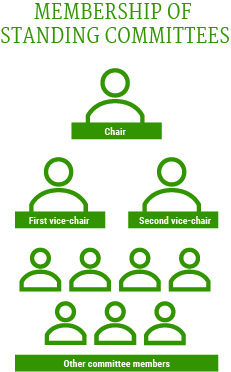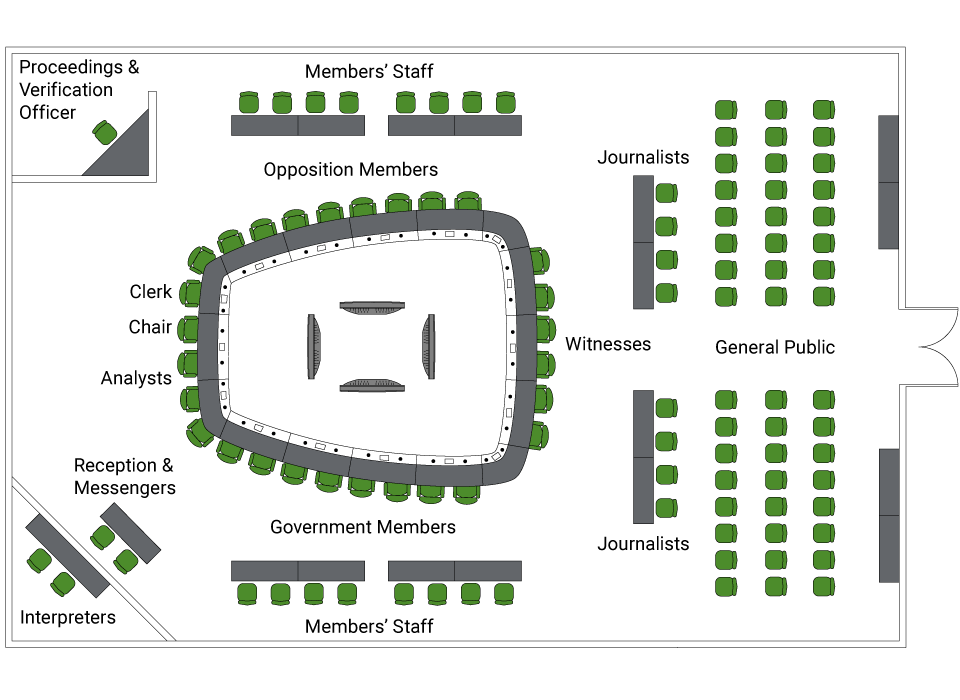Committees
Summary
Committees are parliamentary bodies made up of members of Parliament. They address issues referred to them by the House or those within their mandate. There are standing, legislative, special, and joint committees.
They are mandated to review laws, departmental operations, expenditures, and policies, and undertake studies within the scope of their specific mandate. The House frequently refers matters like bills, reports, estimates, and order-in-council appointments to committees.
Their membership reflects party standings in the House. Committee members can question witnesses and vote. Chairs, elected by the members, preside. Committees are supported by clerks, who provide procedural advice and organize meetings, and analysts, who prepare documents, notes, and reports. Witnesses appearing before committees present their views and answer questions.
Committees organize their work independently and present their findings and recommendations to the House in reports. These reports may request a government response and may include supplementary or dissenting opinions.
Introduction
A committee is a body made up of members of Parliament, or members and senators in the case of joint committees, selected to consider any issue referred to them by the House or related to their mandate. There are different types of committees: standing, legislative, special and joint. Most are standing committees.
Standing committees are established by the Standing Orders of the House of Commons. They are called “standing” because they are automatically renewed at the start of each parliamentary session.
The Standing Orders establish 25 standing committees and two standing joint committees and provide their mandates.
Committee Mandates
Most standing committees are mandated to oversee one or more government departments and are charged with the review of the statute law referred to them by the House, departmental operations and expenditures and the effectiveness of departments’ policies and programs.
Committees are free to initiate any study related to their mandate. The House can also ask them to consider matters through orders of reference.
The House almost systematically refers the following matters to standing committees:
- bills;
- issues requiring in-depth consideration;
- reports and other documents tabled in the House pursuant to a statute;
- estimates, which include the funds requested for government programs and activities;
- non-judicial government appointments; and
- the failure of the government to respond to petitions and to questions on the Order Paper within a given time frame.
Committee Membership, Leadership and Staff
The number of members of standing committees is established in the Standing Orders. However, motions can be adopted to amend the Standing Orders with regard to committee membership for the duration of a Parliament. Party representation on committees reflects the standings of recognized parties in the House. A committee’s members are listed on the home page of its website.

Various key players help carry out committee work. They include:
- Committee Members
- They are entitled to question witnesses, move motions, vote and be part of quorum.
- Substitute Members
- They can replace permanent members in one or more meetings and have the same rights as the members they are replacing.
- Members Who Are Not Committee Members
- Any member can attend a public committee meeting and participate in its proceedings at the discretion of the committee, but cannot move motions, vote or be part of quorum.
- Associate Members
- They can act as substitutes and be named to subcommittees.
- Chairs
- They are elected by the members of the committee and chosen from among the government members of the committee with the exception of four standing committees and one standing joint committee where the chairs are chosen from the official opposition. The chair serves as the presiding officer of the committee and the spokesperson through whom all matters are channelled.
- Vice-Chairs
- They are two per committee and they are elected by the members. The first vice-chair is chosen from the official opposition members of the committee, and the second vice-chair from an opposition party other than the official opposition, except for the five committees chaired by the official opposition. A vice-chair presides over meetings when the chair is absent.
- Committee Clerks
- They are non-partisan and independent officers of committees who provide procedural advice and organize committee meetings. They perform their duties and responsibilities under the direction of the committee and its Chair.
- Analysts
- They are specialists in the subject area considered by the committee; their work includes preparing background documents, briefing notes and draft reports.
- Witnesses
- They are interested groups and experts who provide an opportunity for members of the committee to hear different views on any matter the committee might be considering.
Organization of Business
Committees have a lot of latitude in how they organize their work. They determine their schedules based on the orders of the House and their members’ interests. A committee can study a number of questions at the same time.
For each study, committees can decide how much time they will spend hearing witnesses, how many witnesses they wish to hear from, and which witnesses will appear before them. Committees can also decide to request briefs from groups and individuals who may be unable to appear as witnesses in person or by videoconference.
Before a committee can begin its work, the members of the committee must elect a chair. This occurs at the first meeting of the committee, which is referred to as the “organization meeting.” During this meeting, the committee often elects the vice-chairs and establishes its own rules of procedure for the duration of a session of Parliament.
Here is the usual order of business for a committee study leading to a report:

- Decision to conduct a study
- Drafting of work plan, schedule of work, and witness list
- Briefings to committee members
- Hearing of witnesses and gathering of advice and opinions
- Proceedings relating to draft report
- Review, revision, and adoption of the report
- Presentation of the report to the House
- Government response, if a committee has requested one
- In light of the response, the committee may resume its study
Physical Setting, Types and Conduct of Meetings
Meetings are usually held in one of the designated committee rooms that are located throughout the parliamentary buildings. These rooms are specially outfitted with electronic equipment for the recording, broadcasting and simultaneous interpretation of the proceedings, as well as remote participation.
Here is an example of a typical committee room setup:

Every meeting:
- the chair calls a meeting to order once quorum (the minimum number of members required) is present;
- if there are witnesses, they will make introductory remarks, which are then followed by rounds of questioning from the members of the committee; and
- members can also discuss other matters.
Most meetings are held in public; however, committees can sit in camera (in private) and usually do so when studying draft reports or discussing future business.
Members may participate in committee meetings either in person or remotely, as long as they are within Canada. They all count toward quorum. Only the member chairing the meeting is required to participate in person.
From time to time, committees travel outside the Parliamentary Precinct to hear evidence, hold consultations or visit locations in connection with their studies. To hold such meetings, committees must obtain the authorization of the House and the approval of the Liaison Committee, which releases the necessary funds. Members must participate in meetings in person when committees are travelling.
Reporting of Activities and Deliberations
Notice of Meeting
The members and the public are informed of the Chair’s intention to convene a meeting by means of a notice. A notice is sent via e-mail to every member of the committee as well as the member’s staff. The notice is also published on the Internet on the committee’s website. The notice outlines the purpose, location and time of the meeting, as well as the witnesses (if any) and the informal agenda.
Broadcast of Committee Proceedings
All committee meetings, except those held in camera, are broadcast live over the Internet in both official languages on ParlVu, the House of Commons' webcast service. Televised meetings are also broadcast on the Cable Public Affairs Channel (CPAC) and on the internal House of Commons television channels.
Evidence
Shortly after a meeting has been held, the unofficial transcripts (commonly known as the “blues”) are available for committee members and staff. These unedited transcripts are prepared in the language that was spoken by the participants at the meeting. The official transcripts (translated and edited) are published as soon as possible after the meeting as the Evidence on the committee’s website, usually within 10 calendar days.
Minutes of Proceedings
The Minutes of Proceedings are the official record of business that occurred during a meeting of the committee. The committee clerk prepares the Minutes and publishes them online as soon as possible after a meeting.
Reports
Presenting a report to the House is the way a committee makes public its findings and recommendations on a particular topic. Reports are also available online.
The committee can ask the government to respond to its recommendations within 120 calendar days after the presentation of the report. In addition, pursuant to the Standing Orders, dissenting or supplementary opinions (i.e., a brief text providing additional comment) may be attached to subject-matter reports.
Websites and Social Media
Committees share information on their website and on X. Check in regularly on ourcommons.ca and follow them @HoCCommittees.

For More Information:
- House of Commons Procedure and Practice, third edition, 2017
- Standing Orders of the House of Commons
- Guide for Witnesses Appearing before House of Commons Committees, Committees Directorate
- Guide for Submitting Briefs to House of Commons Committees, Committees Directorate
- Committees Website